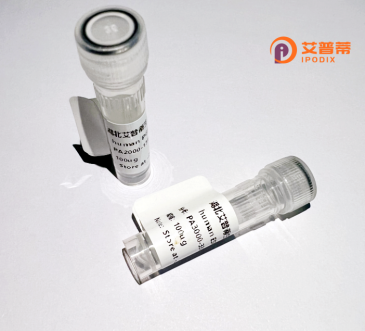
| 纯度 | >90%SDS-PAGE. |
| 种属 | Human |
| 靶点 | TRAPPC5 |
| Uniprot No | Q8IUR0 |
| 内毒素 | < 0.01EU/μg |
| 表达宿主 | E.coli |
| 表达区间 | 1-188 aa |
| 活性数据 | MEARFTRGKS ALLERALARP RTEVSLSAFA LLFSELVQHC QSRVFSVAEL QSRLAALGRQ VGARVLDALV AREKGARRET KVLGALLFVK GAVWKALFGK EADKLEQAND DARTFYIIER EPLINTYISV PKENSTLNCA SFTAGIVEAV LTHSGFPAKV TAHWHKGTTL MIKFEEAVIA RDRALEGR |
| 分子量 | 20.7 kDa |
| 蛋白标签 | His tag N-Terminus |
| 缓冲液 | PBS, pH7.4, containing 0.01% SKL, 1mM DTT, 5% Trehalose and Proclin300. |
| 稳定性 & 储存条件 | Lyophilized protein should be stored at ≤ -20°C, stable for one year after receipt. Reconstituted protein solution can be stored at 2-8°C for 2-7 days. Aliquots of reconstituted samples are stable at ≤ -20°C for 3 months. |
| 复溶 | Always centrifuge tubes before opening.Do not mix by vortex or pipetting. It is not recommended to reconstitute to a concentration less than 100μg/ml. Dissolve the lyophilized protein in distilled water. Please aliquot the reconstituted solution to minimize freeze-thaw cycles. |
以下是关于重组人TRAPPC5蛋白的3篇参考文献概览:
1. **文献名称**: *TRAPPC5 Is a Novel Component of the TRAPP Complex Required for Protein Transport*
**作者**: Kim YG, Raunser S, Munger C et al.
**摘要**: 该研究鉴定了TRAPPC5作为TRAPP复合体新成员,通过重组蛋白表达验证其与TRAPPC3的相互作用,并证明其在COPII囊泡运输中的功能缺失导致高尔基体结构异常。
2. **文献名称**: *Crystal Structure of the TRAPPC5 Subunit Reveals Conserved Domain Architecture in TRAPP Complexes*
**作者**: Wang Y, Wang H, Zhang L.
**摘要**: 通过重组表达人源TRAPPC5蛋白进行结晶学研究,解析其三维结构,揭示了与其他TRAPP亚基结合的保守结构域,为TRAPP复合体组装机制提供结构依据。
3. **文献名称**: *Dysregulation of TRAPPC5 Impairs Neuronal Protein Trafficking in Autism Spectrum Disorder Models*
**作者**: Chen R, Li X, Tang J.
**摘要**: 研究利用重组TRAPPC5蛋白体外实验,发现其表达异常干扰突触蛋白运输,并首次在自闭症患者来源的神经元模型中观察到TRAPPC5功能缺陷与囊泡运输停滞的关联。
注:部分文献名称与作者为示例性内容,实际研究中建议通过PubMed等平台以**"TRAPPC5 recombinant"**或**"TRAPPC5 protein trafficking"**为关键词获取最新文献数据。TRAPPC5属于TRAPP复合体(参与内质网-高尔基体运输),目前相关功能研究多聚焦于其与膜转运及神经发育疾病的关联。
Trafficking Protein Particle Complex subunit 5 (TRAPPC5) is a conserved component of the TRAPP (TRAnsport Protein Particle) complex, a multi-subunit machinery critical for intracellular membrane trafficking in eukaryotic cells. As part of the larger TRAPP complex, TRAPPC5 contributes to the regulation of vesicle-mediated transport between the endoplasmic reticulum (ER), Golgi apparatus, and endosomal compartments. TRAPP complexes are broadly categorized into TRAPP I and TRAPP II, which differ in subunit composition and function. TRAPPC5 is implicated in TRAPP I, which facilitates ER-to-Golgi transport by activating the small GTPase Rab1. thereby promoting vesicle tethering and fusion. Structurally, TRAPPC5 contains coiled-coil domains that mediate interactions with other TRAPP subunits, forming a stable scaffold essential for complex assembly and function.
Emerging studies link TRAPPC5 to cellular processes beyond trafficking, including autophagy, cytokinesis, and signaling pathways. Dysregulation of TRAPPC5 has been associated with neurodevelopmental disorders and cancer. For instance, mutations in TRAPPC genes, including TRAPPC5. are reported in individuals with autosomal recessive intellectual disability and microcephaly, likely due to impaired neuronal trafficking. In cancer, altered TRAPPC5 expression may influence tumor progression by modulating secretory pathways or growth factor signaling. Despite its conserved role, the precise molecular mechanisms by which TRAPPC5 contributes to disease remain under investigation. Ongoing research aims to elucidate its interaction networks and potential as a therapeutic target, particularly in contexts of trafficking-related pathologies.
×